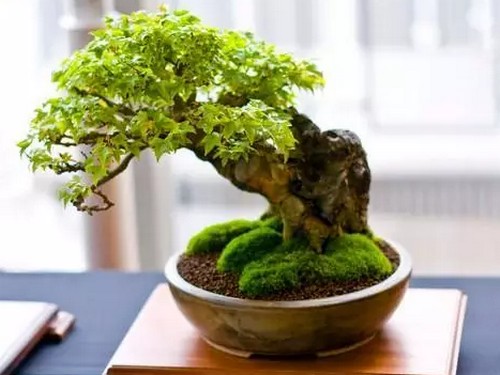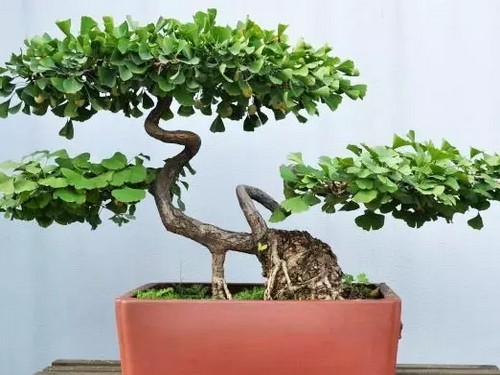Selection and cultivation of bonsai of Acer truncatum
There will be no pruning of the roots for 5 years. However, I found that five years later, the root grew thick and long, it was difficult to dig out of the ground, and the root disk was not ideal. Not only is it much easier to dig up, but pruning the roots every year will promote the formation of fine roots. Of course, annual pruning will slow down the growth rate, but I think it is worthwhile to trade the loss of growth rate for a big improvement in quality.

Miniature triangular maple bonsai, the main root is solid, twisted protuberance, very ornamental. The summer shade covers the ground, and the autumn leaves turn dark red and delicious. The triangular maple tree is graceful, the leaf shape is beautiful, the leaf tip is three-lobed, just like duck flippers, it is quite ornamental. At the beginning of spring, the new leaves are beautiful and green; after autumn, the leaves turn to dark red or old yellow, which is more pleasing to the eye.
Artificial reproduction:
There are cutting, grafting, sowing and other methods, usually by sowing and propagation.
When the seeds mature in October, they should be harvested in time, select full and full seeds, remove sundries from fruit wings, wash and dry them, and store them in stratified sand. Sow in early spring in February-March of the following year, strip sowing or on demand sowing can be 1-2 cm deep. Cover with fine soil, it is better not to see the seeds, cover with straw, pour water thoroughly, sprout and unearth about 40 days after sowing, and remove the grass cover in time after emergence. In summer, the tower shed should be shaded to prevent the scorching sun, and the soil should be often watered to keep the soil moist. During the growth of seedlings, thin and rotten cake fertilizer and water can be applied 1-2 times to promote growth. The seedlings can be as high as 30-40 cm in that year, and then be planted in pots after leaving the bed for a year.
Cutting propagation with plum rain season is better, cuttings select the same year's semi-ripe twigs, 10-20 cm long, retain 3-7 leaf nodes, the upper leaves 2-4 leaves, the rest erased; deep 1B2, shading after planting, proper watering, about 1 month later can take root, remove the shade, fully accept the light, so that cutting seedlings grow healthily. The following spring, it was transplanted into the basin. Grafting propagation was carried out in March or Meiyu period with the original species of Acer as rootstock, and the survival rate was also high.
Mountain mining:
The old root pile of wild Acer truncatum in the mountain area was used to "raise the embryo" for 1-2 years after digging back. After the root system developed and new branches and leaves sprouted, it was processed in the basin, pruned and clambered to make a certain form of pile scene. The triangular maple bonsai made in this way has the advantages of quaint and simple, fast shaping, high ornamental value, and can get the effect of half the work and twice the effort.
Cultivation of bonsai materials of Acer truncatum
When I used to cultivate maple material, I usually kept it in the field for 5 years. There will be no pruning of the roots for 5 years. However, I found that five years later, the root grew thick and long, it was difficult to dig out of the ground, and the root disk was not ideal. Now I dig up and trim the roots every year. Not only is it much easier to dig up, but pruning the roots every year will promote the formation of fine roots. After shaping in the future, the root disk will be more symmetrical and beautiful. Of course, annual pruning will slow down the growth rate, but I think it is worthwhile to trade the loss of growth rate for a big improvement in quality.
▲ dug up the triangular maple in winter
▲ then trims the roots. I cut it short. It can be seen that the root disc has grown well, thanks to the early root culture. How to cultivate the roots, which will be discussed below.
▲, these are all trimmed.
Some of these materials in the picture above will be used for direct pot maintenance, and the rest will continue to be stocked in the field.
If you want to cultivate a good-looking root plate of Acer triangulata, you need to lose the main root before the initial sapling goes to the ground. Generally speaking, the main root is vertically downward and very long. Cutting off the main root will stimulate the germination of the lateral root.
▲ pruned the root for the first time, cutting off the main root, leaving only the lateral root.
▲ trimmed the root again, and the result was satisfactory.
That is to first find a piece of iron plate of the right size, and drill a small hole in the middle of the iron plate, which is a little larger than the trunk diameter of the triangle maple seedling. Put the seedlings of Acer truncatum into the holes and plant them. That is, the root of the seedling is under the iron plate, and the branches are on the iron plate. As the diameter of the trunk thickens and fills the holes, the water and nutrient supply of the upper trunk is gradually interrupted, and the upper trunk will form a lot of lateral roots near the iron plate. These lateral roots tend to be evenly distributed and on the same horizontal line.
This method is similar to the high-altitude pressure strip (binding method) we talked about earlier. Those who are interested can read the previous article.
▲ is a triangular maple grown on an iron plate.
After ▲ removed the iron plate and trimmed the root, the root was very flat and there was no pressure on the upper shallow basin.
"restrain the main root, stimulate the lateral root" can not only cultivate an excellent root disk, it also has another advantage. When the stump is more dependent on the lateral root, the base of the trunk will thicken rapidly, and the whole trunk can form a better thickness transition.
The above opinions are my experience in cultivating Acer truncatum over the years. Of course, these methods are not limited to the cultivation of Acer truncatum. It is also applicable to other tree species. Those who are interested can try it.
Time: 2019-06-02 Click:
- Prev

Material selection and cultivation of strange willow bonsai
Tamarix, alias Sanchun willow, red willow, sand willow, is a shrub or small tree of the genus Tamarix of Tamarix family. It is one of the main representative tree species of Zhongzhou bonsai. It can grow well under almost any conditions, with strong germination, easy to live and fast to form. The leaf shape is novel, the flower color is beautiful, the florescence is long, and the flower does not fall.
- Next

Material selection and cultivation of Ginkgo biloba bonsai
Ginkgo biloba is a kind of tree species that has survived for a long time. Since ancient China, it has been regarded as a good selection of bonsai materials. The types of ginkgo bonsai can be divided into three types: leaf viewing, fruit viewing and pile viewing. In order to make ginkgo bonsai, we should choose the root tillering seedlings under the big trees and the stalactite branches of ginkgo trees.
Related
- Fuxing push coffee new agricultural production and marketing class: lack of small-scale processing plants
- Jujube rice field leisure farm deep ploughing Yilan for five years to create a space for organic food and play
- Nongyu Farm-A trial of organic papaya for brave women with advanced technology
- Four points for attention in the prevention and control of diseases and insect pests of edible fungi
- How to add nutrient solution to Edible Fungi
- Is there any good way to control edible fungus mites?
- Open Inoculation Technology of Edible Fungi
- Is there any clever way to use fertilizer for edible fungus in winter?
- What agents are used to kill the pathogens of edible fungi in the mushroom shed?
- Rapid drying of Edible Fungi

